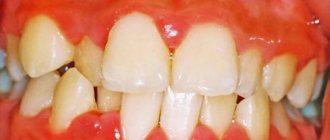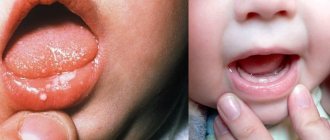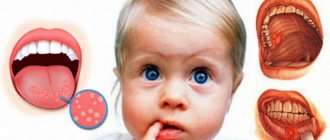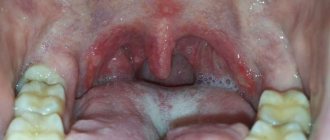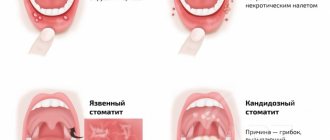- home
- Articles
- Treatment of stomatitis in the mouth in adults and children
Damage to the mucous membranes of the mouth is called stomatitis. The disease can occur in several types, each of which requires a special type of treatment. That is why you cannot take any medications on your own, since the incorrect selection of medications will only aggravate the course of the disease.
What it is
This type of stomatitis is provoked by enteroviruses entering the body. The very concept of “enterovirus” unites a large number of viral infections that actively multiply in the human gastrointestinal tract when they enter it with water, with agricultural products or from animal carriers. The virus can also be transmitted through blood-sucking insects, entering directly into the blood and ultimately leading to the development of vesicular stomatitis.
Due to their increased resistance to high acidity, detergents and even chlorine in running water, enteroviruses can survive in unboiled milk and cold-leavened dairy products, on the surface of vegetables, fruits and herbs for up to three to four months. The only way to combat them is heat treatment at a temperature of at least fifty degrees.
Enteroviral stomatitis does not occur in all people who become ill under the influence of this group of viruses, however, the occurrence of vesicular inflammation during enterovirus infection is far from uncommon, especially if there are microdamages to the mucous membrane in the oral cavity.
Symptoms of stomatitis
You can determine the onset of the disease with the naked eye by examining the oral cavity.
In patients of different ages, stomatitis manifests itself with the following symptoms:
- The mucous membrane becomes covered with aphthae-ulcers. They may also appear on the tongue.
- It becomes painful for the patient to eat and drink due to irritated mucous membranes, and children become restless and cry constantly.
- Most often there is a fever (up to about 38 degrees).
- The patient complains of a constant feeling of pain and burning in the mouth.
For quick and proper treatment of stomatitis, you need to visit a doctor immediately after detecting the initial symptoms of illness. In some immunocompromised patients, the disease progresses rapidly and can cause blood poisoning.
Causes
Enteroviruses themselves exist everywhere, and it is impossible for humans to avoid encountering them. However, these viruses do not provoke disease in all people, much less the formation of vesicular stomatitis. The most important prerequisite for its onset is a reduced level of the body’s resistance to infections due to weakened immunity.
Main methods of infection:
- airborne droplets (when talking to a carrier, sneezing, coughing);
- contact (through common objects);
- fecal-oral (when the virus gets from manure used for fertilizer onto vegetables, herbs and fruits).
The main viral agents that can be called vesicular stomatitis viruses are enterovirus 71 and Coxsackie viruses.
The risk of the disease in adults is very small; children in the first two to three years of life mainly suffer from this complication of enterovirus infection. Peaks of incidence occur in autumn and spring, and in warmer countries the risk of getting sick increases from mid-summer, since with high air temperatures and high humidity, the lifespan of the virus outside the host’s body increases greatly.
Types of enteroviruses
There are more than 100 causative agents of this infection. The main ones are ECHO, polioviruses (the causative agents of polio), Coxsackie viruses A and B, and enteroviruses that cannot be classified.
Coxsackie viruses are several serotypes of the pathogen belonging to groups A, B and C. Coxsackie viruses type A are the cause of severe forms of enteroviral diseases. These are hemorrhagic conjunctivitis, herpetic sore throat, aseptic meningitis. Type B is more dangerous because it provokes hepatitis, myocarditis, and pericarditis. Source: V.V. Botvinyeva, L.S. Namazova-Baranova, O.B. Gordeeva, O.K. Botvinyev, T.N. Konopleva Modern possibilities for diagnosis, prevention and treatment of Coxsackie enterovirus infection in children // Pediatric pharmacology, article received: 01/22/2012, accepted for publication: 05/12/2012.
ECHO viruses are most dangerous for newborns. In them they cause meningitis, myocarditis, and hepatitis. This often causes death. There are no complications in older children.
Symptoms
Most often, the disease caused by enteroviruses is asymptomatic, but some patients (up to three percent of all infected) experience serious complications. The most common of them is enteroviral vesicular stomatitis with exanthema, i.e. rashes (grayish-white vesicles) localized on the palms, soles and mouth (on the inner surface of the cheeks, on the lips, tongue and even in the throat). It is thanks to this localization of the rash that vesicular stomatitis with exanthema received another name, often used among the people - “arm, leg, mouth” syndrome.
In addition to the characteristic rash with severe itching, increased salivation and pain when swallowing, this disease may be accompanied by increased body temperature and fever, weakness, chills, muscle pain, hyperemia and swelling of the soft tissues of the oral cavity, headaches and pain in the gastrointestinal tract, nausea, vomiting or diarrhea, runny nose and sore throat, and photophobia.
Since rashes appear later than other symptoms, clinic doctors often make the wrong diagnosis: acute respiratory infections, acute respiratory viral infections, allergies, dermatitis, rotavirus infection, herpes, and even simple teething. Accordingly, medications are prescribed that eliminate some of the symptoms, but blur the picture of the underlying disease.
In fact, with a fairly mild course of the disease, no specific treatment for enteroviral vesicular stomatitis is required. The first signs appear five to six days after infection, blisters appear around the third day, and after seven to ten days the patient fully recovers.
The incubation period for this infection can vary from a couple of days to a week. In the initial stages of the disease, the infectiousness of the infected person is much higher than in recent days, however, the elimination of enterovirus in feces can continue for up to a month after the onset of the disease.
Vesicular stomatitis: before and after photos
The disease vesicular stomatitis mainly occurs in the summer, when insects become more active. 2-6 days after the virus enters the body, a person begins to feel a headache and chills, he has a fever, enlarged cervical lymph nodes, a runny nose, and ulcers affect the lips, gums, inner surfaces of the cheeks and tongue. Rashes with vesicular stomatitis are quite painful, so eating causes severe discomfort.
How to treat
Since a sick child is contagious to the entire group of children (adults are least susceptible to the disease), the first step is to isolate him from other children. If you find rashes on the oral mucosa, you need to contact your dentist, who will tell you how to treat vesicular stomatitis.
Most often, no specific treatment is prescribed. In case of increased pain, the child may be prescribed painkillers, local applications and rinses. Antiviral drugs and vitamin-mineral complexes may also be prescribed to support immunity. During the period of illness, it is necessary to carefully observe hygiene, be sure to wash your hands with soap after visiting the toilet and before eating.
Treatment of vesicular stomatitis
When treating vesicular stomatitis, symptomatic therapy is prescribed, including:
- drinking plenty of water;
- complete rest;
- treatment of the oral mucosa with antiseptic solutions;
- taking antipyretic drugs;
- the use of antiviral ointments (oxolinic, redoxol, tebrofen).
As a rule, vesicular stomatitis does not cause complications, and signs of the disease quickly go away if the patient strictly follows the doctor’s instructions.
A childhood viral disease is also treated quite quickly and goes away without a trace if you see a dentist on time. As a medicine, the doctor may recommend taking an immunomodulator, which will help cope with the disease and will be an excellent prophylactic for the prevention of other viral diseases.
Treatment of vesicular stomatitis of the enteroviral type is generally carried out in the same ways as usual, that is, it is symptomatic. The disease cannot be neglected, as there is a risk of developing such serious complications as meningitis, encephalitis and acute flaccid paresis.
Another important point in the treatment of vesicular stomatitis in children is the isolation of children from the group so that the disease is not transmitted to others. And do not forget that hygiene items (in particular, a towel) must be individual.
Treatment
Treatment of enterovirus infection is usually carried out at home. Hospitalization is resorted to only in extreme cases: when it is not possible to reduce the high temperature for a long time, there are symptoms of dehydration, signs of damage to the nervous system or heart. During the entire acute period, the small patient must remain in bed. The food recommended is light, but rich in proteins. It is important to provide the child with plenty of drink in the form of boiled water, still mineral water, fruit drinks or compotes.
There is no single universal remedy against enteroviruses. Treatment depends on how the infection manifests itself:
- for fever, antipyretics are prescribed;
- for diarrhea, medications are prescribed to help stop diarrhea and restore water and electrolyte balance;
- a number of local symptomatic care products (sprays, gargles, nasal rinsing solutions, eye drops, etc.);
- if there are bacterial complications, antimicrobial drugs are prescribed.
If your baby is sick, contact CELT! We have experienced pediatricians who will identify the cause of the disease and help eliminate the existing symptoms!
Make an appointment through the application or by calling +7 +7 We work every day:
- Monday—Friday: 8.00—20.00
- Saturday: 8.00–18.00
- Sunday is a day off
The nearest metro and MCC stations to the clinic:
- Highway of Enthusiasts or Perovo
- Partisan
- Enthusiast Highway
Driving directions
How does infection occur?
Enterovirus infection is seasonal. Its peak usually occurs in summer and autumn. The source is a patient or a carrier of the virus. Children who are carriers of enterovirus infection have no symptoms of infection, but, nevertheless, viruses are present in the intestines, and they are excreted together with feces. Carriers are children who have clinically recovered or have not become ill at all, despite infection with enterovirus. This is possible if the child’s body has strong immunity. The virus can live in the intestines for up to five months.
Enteroviruses can live for a long time in soil and water. Moreover: they can survive for several years in a frozen state, are not afraid of the effects of disinfectants, but die when exposed to high temperatures, from +45°C.
The mechanism of transmission of enteroviral infections in children can be:
- airborne: with drops of saliva when sneezing or coughing;
- nutritional: with a low level of personal hygiene;
- aqueous: when consuming raw water;
- household: through toys, cutlery, door handles.
Prevention
The basis for the prevention of enterovirus infection in a child is compliance with the rules of hygiene:
- washing hands and food before consumption;
- boiling water;
- avoiding places where large numbers of people gather during an epidemic.
- It is extremely important to take measures to increase immunity: follow a routine, eat right, and harden yourself.
In the pediatric medical department, all conditions have been created for the diagnosis and treatment of enterovirus infection in a child. For seriously ill patients, the department operates a 24-hour hospital, where the small patient will be under the constant supervision of qualified medical personnel and doctors. Remember that the sooner the correct diagnosis is made and the type of virus is determined, the easier it will be to cure the child and avoid complications.
Sources:
- G.P. Martynov. Enterovirus (non-polio) infection in children // Siberian Medical Review, 2014.
- V.V. Botvinyeva, L.S. Namazova-Baranova, O.B. Gordeeva, O.K. Botvinyev, T.N. Konopleva. Modern possibilities for diagnosis, prevention and treatment of Coxsackie enterovirus infection in children // Pediatric pharmacology, article received: 01/22/2012, accepted for publication: 05/12/2012.
- A.V. Demina, V.A. Ternova, N.I. Shulgina, S.V. Netesov. Enteroviruses. Part 3. Laboratory diagnostics, treatment, immunoprophylaxis // Bulletin of the Siberian Branch of the Russian Academy of Medical Sciences, volume 31, No. 3, 2011.
Markova Daria Olegovna Clinic
Author of the article
Markova Daria Olegovna
Specialty: pediatrician
Experience: 15 years
The information in this article is provided for reference purposes and does not replace advice from a qualified professional. Don't self-medicate! At the first signs of illness, you should consult a doctor.




